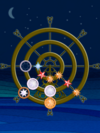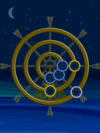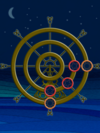Duty nav scoring
| The values used in this article are for the purposes of demonstrating relative values only. | |
| The actual mechanical values behind the puzzle are undisclosed. |
Basic points
As always for duty puzzle mechanics, these points are completely arbitrary and serve merely to demonstrate relative values:
- Star falling onto the board: -1 point
- A certain amount of time passes: -1 point
- Moving a rung: 0 points
- Clearing a row or column of 3 adjacent pieces: 6 points
- Clearing a row of 4-5 pieces: 8-10 points.
This illustrates pretty clearly that the main goal in navigation is piece efficiency. You want to use as few stars as possible to meet your puzzle goals. Puzzling fast helps, but like bilge, you're best to take your time and avoid making bad moves.
Cascades
Cascades in Navigation occur after you clear a row or constellation, and the remaining stars form another row or constellation. Cascades are linear multipliers- a two-step cascade rewards double points for its second step, a three-step cascade rewards triple points for its third step, and so on. So using our made-up points above, a three-step combo with each step clearing a row of 3 would be worth 36 points.
Like in Bilge, cascades are a secondary scoring mechanic. Cascading rows of stars is much less beneficial than clearing a constellation. The most points, however, are available from cascading a constellation- but this can only be done with the easier constellations that don't take up too much space of the board.
Constellations
Constellations is the navigation term for the puzzle's targets- the colored rings which contain outlines matching the shapes of the same-colored stars. The bonus from more difficult constellations increases faster than the number of pieces usually required to clear them, so the difficulty of the puzzle scales directly with the type of constellations that show up.
Because the puzzle always starts out with a relatively easy constellation that doesn't net many initial points, it's always harder on ratings to navigate short journeys. Ramping up through these constellations quickly while still maintaining a good piece balance is one of the challenges of navigating at higher ratings. Because of the effect of the scaling difficulty of these constellations, navigators who haven't yet finished doing short voyages memorising the ocean will often experience fluctuating ratings while they learn routes.
Notes on difficulty
Difficulty of constellations is determined by several factors, including total number of stars in a constellation, the color balance of the whole constellation, proximity of those stars to each other, the colors of adjacent stars, and whether these form any adjacent rows of three of the same color.
As the difficulty of navigation ramps up, much more difficult puzzles will begin to show up, eventually to the point where the highest-rated navigators will actually see a couple of impossible puzzles.
|
| ||
Important disclaimer: All point values used within these pages reflect relative values and weights as determined by players. No developer has commented on the current accuracy of any of these. Any forum post from developers that gave point scoring information is from pre-release days (pre-Midnight), and potentially has been changed. In particular, sailing (at least) has been known to have had major changes to scoring at least once. Use at your own risk. Past performance is no guarantee of future potential. Scoring may be changed in any update. Star levels do change the challenges that you face, and may change the scoring; the same play at different star levels may score differently. While this is known to be true in bilge, it potentially may be true in any puzzle.



